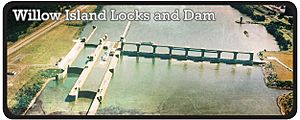Willow Island Lock and Dam facts for kids
Quick facts for kids Willow Island Lock and Dam |
|
|---|---|
 |
|
| Official name | Willow Island Lock and Dam |
| Location | Ohio/West Virginia border |
| Coordinates | 39°21′33″N 81°19′09″W / 39.3593°N 81.3193°W |
| Construction began | 1967 |
| Opening date | 1976 |
| Construction cost | $76,520,800 |
| Operator(s) | |
| Dam and spillways | |
| Type of dam | Gated |
| Impounds | Ohio River |
| Length | 1,128 feet |
| Reservoir | |
| Normal elevation | 602 feet above sea level |
The Willow Island Lock and Dam is a very important structure on the Ohio River. It helps boats and barges travel safely along the river. This dam is the seventh one you would find if you started at Pittsburgh and traveled downstream. It's located about 162 miles from Pittsburgh.
This special structure has two main parts: a dam and two locks. The dam controls the water level, and the locks act like elevators for boats. They help boats move between different water levels.
Contents
What is a Lock and Dam?
A lock and dam system is like a giant staircase for a river. Rivers naturally flow downhill, which means their water levels change. Sometimes, the water is too shallow for big boats. Other times, there are rapids or waterfalls.
How a Lock Works
A lock is a chamber with gates at both ends. When a boat wants to go upstream (to a higher water level):
- The boat enters the lock from the lower side.
- The lower gate closes behind it.
- Water is slowly added to the lock chamber.
- The boat rises with the water until it reaches the higher level.
- The upper gate opens, and the boat leaves.
When a boat wants to go downstream (to a lower water level):
- The boat enters the lock from the higher side.
- The upper gate closes behind it.
- Water is slowly let out of the lock chamber.
- The boat lowers with the water until it reaches the lower level.
- The lower gate opens, and the boat leaves.
This system makes the river navigable for large ships and barges.
The Dam's Role
The dam part of Willow Island Lock and Dam helps control the water level. It creates a pool of deeper water upstream. This deeper water is needed for large boats to float easily. The dam also helps manage floods and ensures there's enough water for different uses.
Willow Island's Features
The Willow Island Lock and Dam is quite large. It has two locks to handle different amounts of river traffic.
Main Lock for Barges
The main lock is designed for big commercial barges. These barges carry lots of goods, like coal, grain, or oil.
- It is 1,200 feet long. That's longer than three football fields!
- It is 110 feet wide. This allows very wide barges to pass through.
Auxiliary Lock
There is also a second, smaller lock. This is called the auxiliary lock. It's used when the main lock is busy or needs repairs.
- It is 600 feet long. This is still very long, about one and a half football fields.
- It is also 110 feet wide.
These two locks work together to keep river traffic moving smoothly.
Building the Dam
Building a structure as big as the Willow Island Lock and Dam takes a lot of time and effort.
- Construction started in 1967.
- It took almost 10 years to build.
- The dam officially opened in 1976.
- The total cost was about $76.5 million. This was a lot of money back then!
The United States Army Corps of Engineers is in charge of operating and maintaining the dam. They make sure it works properly and keeps the river safe for everyone.
| Locks and dams of the Ohio River | ||
|---|---|---|
|
||
| Upstream: Hannibal Locks and Dam |
Downstream: Belleville Lock and Dam |
|

